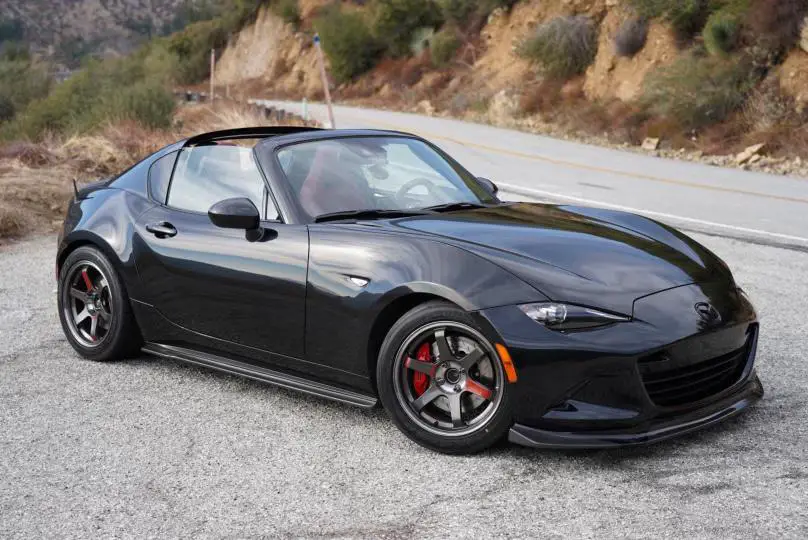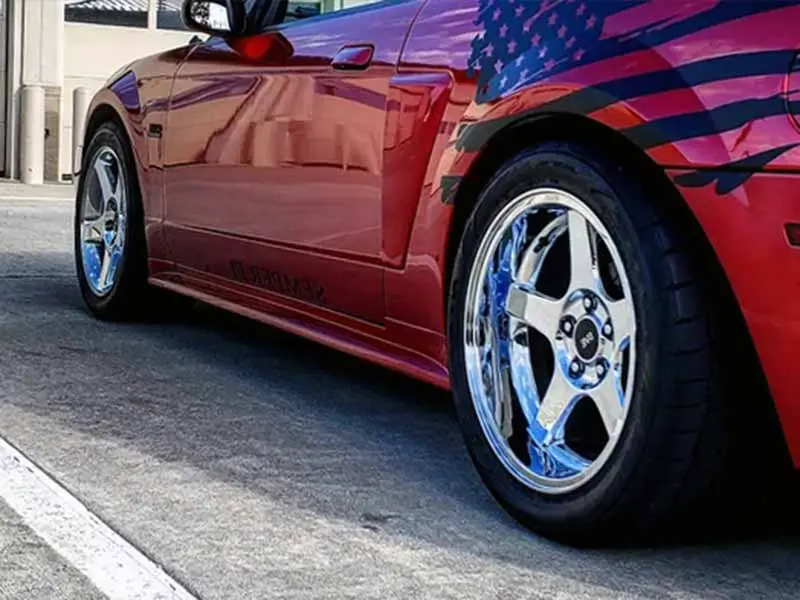Ever wondered why some cars seem to hug the road better, especially around tight corners or during high-speed driving? The secret might be in their wheels—more specifically, their staggered wheels. If you’re curious about what makes these wheels special and whether they’re the right fit for your vehicle, you’ve come to the right place.
What Are Staggered Wheels?
Staggered wheels are a tire setup where the rear wheels and tires are wider than the front ones. This setup is primarily used to improve traction, stability, and cornering in rear-wheel-drive cars and trucks.
In this article, we’ll delve deep into the world of staggered wheels, exploring how they work, their pros and cons, and their compatibility with different types of drive systems. We’ll also discuss special considerations for larger wheels in a staggered setup.
Let’s take a closer look.

What Are Staggered Wheels?
Staggering of wheels refer to a specific tire setup where the rear wheels and tires are wider than the front ones. This is different from a standard or “square” setup, where all four wheels and tires are the same size. The term “staggered fitment” is often used to describe this arrangement.
Components of a Staggered Setup
In a staggered wheel setup, you’ll typically find:
- Wider Rear Wheels: The rear wheels are wider than the front wheels.
- Wider Rear Tires: Corresponding to the wider wheels, the rear tires are also wider.
- Front and Rear Axles: The front and rear axles are designed to accommodate the different wheel sizes.
Types of Vehicles That Commonly Use Staggered Setups
Staggered wheels are most commonly found on:
- Sports Cars: Designed for high performance, many sports cars use staggered wheels to maximize grip and handling.
- Luxury Vehicles: Some high-end cars have staggered wheel sizes for both performance and aesthetic reasons.
- Trucks: While less common, some trucks are staggered for better traction and load distribution.
Important Considerations
Before switching to a staggered setup, it’s essential to consider a few things:
- Vehicle Compatibility: Not all vehicles are designed to accommodate staggered wheels. Check your owner’s manual or consult with a professional.
- Cost: Staggered tires and wheels can be more expensive than standard setups.
- Maintenance: Rotating staggered tires, a common maintenance task, is more complicated because the front and rear tires are different sizes.

How Do Staggered Wheels Work?
Staggered setups operate on a simple principle: by having wider wheels and tires at the rear, you can improve the vehicle’s performance in various ways. The wider rear wheels provide a larger contact patch—the area where the tire touches the road. This leads to several advantages, especially for rear-wheel-drive vehicles.
Advantages in Rear-Wheel-Drive Cars and Trucks
Rear-wheel-drive (RWD) vehicles benefit the most from staggered wheels for several reasons:
- Improved Traction: The wider rear tires provide better traction, which is particularly beneficial when accelerating from a standstill.
- Enhanced Stability: The larger contact patch helps to stabilize the vehicle, especially at higher speeds and during cornering.
- Better Weight Distribution: In RWD vehicles, more weight is typically over the rear wheels, making wider rear tires more effective at distributing this weight.
Performance Vehicles
Performance vehicles often come with a staggered tire setup as a standard feature or as an optional upgrade. These vehicles are engineered for speed and agility, and staggering complements these attributes by providing:
- High-Speed Cornering: The wider rear tires offer better grip during high-speed cornering, reducing the likelihood of the rear end sliding out.
- Quick Acceleration: Better traction allows for quicker acceleration, a key performance metric.
How Staggered Wheels Affect Tire Width
In a staggered setup, the width of the tires is a critical factor:
- Front Tires: Usually narrower to allow for better steering response.
- Rear Tires: Wider to provide more traction and stability.
Limitations and Drawbacks
While staggering offer several advantages, they are not without limitations:
- Reduced Fuel Efficiency: The increased rolling resistance from wider tires can lead to slightly lower fuel efficiency.
- Wear and Tear: Wider tires may wear out more quickly, especially if the vehicle is frequently driven at high speeds.

Staggered Vs Square Setup
When it comes to wheel setups, you generally have two options: staggered and non-staggered (often called “square” setups). In a staggered setup, the rear wheels and tires are wider than the front ones. In a non-staggered setup, all four wheels and tires are the same size. Understanding these basic differences is the first step in choosing the right setup for your vehicle.
Performance Differences
The performance characteristics of staggered and square setups vary significantly, particularly in these areas:
- Traction: Staggered wheels offer better traction due to the wider rear tires, especially useful in rear-wheel-drive vehicles.
- Handling: Square setups generally provide more balanced handling, making them better suited for all-wheel-drive (AWD) and front-wheel-drive (FWD) vehicles.
- Steering Response: Square wheel fitments often offer quicker steering response because the front and rear tires are the same size, allowing for more predictable behavior.
Cost Implications
When it comes to cost, there are some differences to consider:
- Initial Cost: Staggered wheels and tires are generally more expensive upfront due to the specialized sizes.
- Maintenance: Square setups are usually cheaper to maintain because you can rotate the tires, extending their lifespan.
Suitability for Different Drive Types
Different drive types can influence the effectiveness of staggered vs square setups:
- Rear-Wheel Drive: Generally benefits more from staggered wheel and tire fitments due to improved traction and stability.
- All-Wheel Drive and Front-Wheel Drive: Often better suited for non-staggered wheels for more balanced handling and steering.
Aesthetics and Style
While performance is a significant factor, aesthetics also play a role:
- Staggered: Often considered more aggressive and sporty in appearance.
- Square: Tend to offer a more classic and balanced look.
Important Considerations
Before choosing between staggered and non-staggered wheels, consider the following:
- Driving Conditions: If you frequently drive in conditions that require better traction and stability, staggered might be the way to go.
- Vehicle Compatibility: Always check your vehicle’s manual or consult with professionals to ensure compatibility with staggering.

Pros and Cons of Staggered Wheels
A staggered application comes with several advantages that can enhance your driving experience, especially if you own a rear-wheel-drive vehicle. Here are some of the key benefits:
- Improved Traction: The wider rear tires offer better grip, making it easier to accelerate and maintain stability.
- Enhanced Cornering: The larger contact patch on the rear tires allows for more secure and confident cornering.
- Aggressive Aesthetics: The wider rear wheels give the vehicle a sportier, more aggressive appearance.
Addressing the Question: Is Staggered Better?
The question of whether staggered wheels are “better” is subjective and depends on various factors:
- Driving Style: If you enjoy spirited driving or own a performance vehicle, staggered wheels can offer a more exhilarating experience.
- Vehicle Type: Staggered wheels are generally more beneficial for rear-wheel-drive cars and trucks, where the advantages are most noticeable.
- Personal Preference: Some people prefer the look of staggered wheels, which can be a deciding factor.
The Drawbacks of Staggered Wheels
While staggered wheels offer several advantages, they are not without their downsides:
- Cost: Staggered wheels and tires are often more expensive, both in initial cost and potential maintenance.
- Limited Rotation: Because the front and rear tires are different sizes, you can’t rotate them, which may lead to faster wear.
- Reduced Fuel Efficiency: The wider rear tires can create more rolling resistance, potentially reducing fuel efficiency slightly.
Special Considerations for Performance Vehicles
For performance vehicles, staggered wheels can be a double-edged sword:
- Positive Impact: They can significantly enhance performance metrics like acceleration and cornering.
- Negative Impact: The increased wear and tear on the tires and potential for reduced fuel efficiency should be considered.
Making an Informed Decision
When weighing the pros and cons of staggered wheels, consider the following:
- Consult Your Vehicle’s Manual: Always check compatibility before making a switch.
- Talk to Professionals: A quick consultation with a tire or automotive expert can provide valuable insights.
- Test Drive: If possible, test drive a vehicle with staggered wheels to get a feel for the differences.
Resources
Below are some links you may find helpful when learning about tires
- Staggered fitment – pros and cons – Discount Tire
- Staggered vs. square tire and wheel setups – Tire Buyer
Final Thoughts
Staggered wheels offer a unique blend of performance and aesthetic benefits, particularly for rear-wheel-drive vehicles. They provide improved traction, better high-speed stability, and a sportier appearance.
However, they also come with their own set of challenges, including higher costs and more complex maintenance. Before making the switch, it’s crucial to consider your driving needs, consult your vehicle’s manual, and perhaps even seek professional advice.
Good luck and happy motoring.




